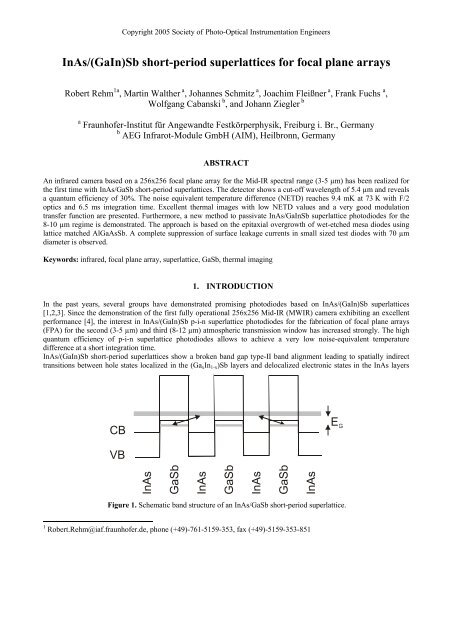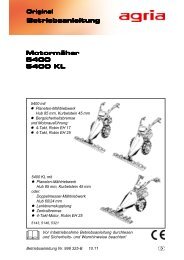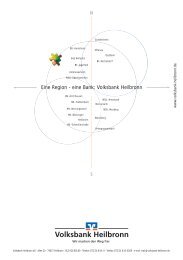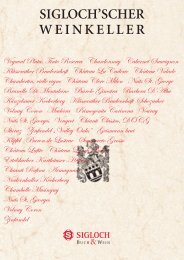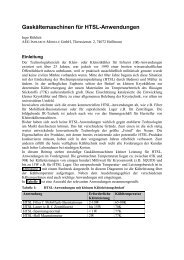InAs/(GaIn)Sb short-period superlattices for focal plane arrays
InAs/(GaIn)Sb short-period superlattices for focal plane arrays
InAs/(GaIn)Sb short-period superlattices for focal plane arrays
Create successful ePaper yourself
Turn your PDF publications into a flip-book with our unique Google optimized e-Paper software.
Copyright 2005 Society of Photo-Optical Instrumentation Engineers<br />
<strong>InAs</strong>/(<strong>GaIn</strong>)<strong>Sb</strong> <strong>short</strong>-<strong>period</strong> <strong>superlattices</strong> <strong>for</strong> <strong>focal</strong> <strong>plane</strong> <strong>arrays</strong><br />
Robert Rehm 1a , Martin Walther a , Johannes Schmitz a , Joachim Fleißner a , Frank Fuchs a ,<br />
Wolfgang Cabanski b , and Johann Ziegler b<br />
a Fraunhofer-Institut für Angewandte Festkörperphysik, Freiburg i. Br., Germany<br />
b AEG Infrarot-Module GmbH (AIM), Heilbronn, Germany<br />
ABSTRACT<br />
An infrared camera based on a 256x256 <strong>focal</strong> <strong>plane</strong> array <strong>for</strong> the Mid-IR spectral range (3-5 µm) has been realized <strong>for</strong><br />
the first time with <strong>InAs</strong>/Ga<strong>Sb</strong> <strong>short</strong>-<strong>period</strong> <strong>superlattices</strong>. The detector shows a cut-off wavelength of 5.4 µm and reveals<br />
a quantum efficiency of 30%. The noise equivalent temperature difference (NETD) reaches 9.4 mK at 73 K with F/2<br />
optics and 6.5 ms integration time. Excellent thermal images with low NETD values and a very good modulation<br />
transfer function are presented. Furthermore, a new method to passivate <strong>InAs</strong>/<strong>GaIn</strong><strong>Sb</strong> superlattice photodiodes <strong>for</strong> the<br />
8-10 µm regime is demonstrated. The approach is based on the epitaxial overgrowth of wet-etched mesa diodes using<br />
lattice matched AlGaAs<strong>Sb</strong>. A complete suppression of surface leakage currents in small sized test diodes with 70 µm<br />
diameter is observed.<br />
Keywords: infrared, <strong>focal</strong> <strong>plane</strong> array, superlattice, Ga<strong>Sb</strong>, thermal imaging<br />
1. INTRODUCTION<br />
In the past years, several groups have demonstrated promising photodiodes based on <strong>InAs</strong>/(<strong>GaIn</strong>)<strong>Sb</strong> <strong>superlattices</strong><br />
[1,2,3]. Since the demonstration of the first fully operational 256x256 Mid-IR (MWIR) camera exhibiting an excellent<br />
per<strong>for</strong>mance [4], the interest in <strong>InAs</strong>/(<strong>GaIn</strong>)<strong>Sb</strong> p-i-n superlattice photodiodes <strong>for</strong> the fabrication of <strong>focal</strong> <strong>plane</strong> <strong>arrays</strong><br />
(FPA) <strong>for</strong> the second (3-5 µm) and third (8-12 µm) atmospheric transmission window has increased strongly. The high<br />
quantum efficiency of p-i-n superlattice photodiodes allows to achieve a very low noise-equivalent temperature<br />
difference at a <strong>short</strong> integration time.<br />
<strong>InAs</strong>/(<strong>GaIn</strong>)<strong>Sb</strong> <strong>short</strong>-<strong>period</strong> <strong>superlattices</strong> show a broken band gap type-II band alignment leading to spatially indirect<br />
transitions between hole states localized in the (GaxIn1-x)<strong>Sb</strong> layers and delocalized electronic states in the <strong>InAs</strong> layers<br />
VB<br />
<strong>InAs</strong><br />
Ga<strong>Sb</strong><br />
<strong>InAs</strong><br />
Ga<strong>Sb</strong><br />
<strong>InAs</strong><br />
Ga<strong>Sb</strong><br />
<strong>InAs</strong><br />
E G<br />
Figure 1. Schematic band structure of an <strong>InAs</strong>/Ga<strong>Sb</strong> <strong>short</strong>-<strong>period</strong> superlattice.<br />
1 Robert.Rehm@iaf.fraunhofer.de, phone (+49)-761-5159-353, fax (+49)-5159-353-851
(see Figure 1). The effective band gap EG of these structures can be adjusted from 0.3 eV to values below 0.1 eV by<br />
varying the thickness of the <strong>InAs</strong> layer or the indium mole fraction in the (GaxIn1-x)<strong>Sb</strong>. The growth is per<strong>for</strong>med by<br />
Molecular Beam Epitaxy (MBE) on 2” Ga<strong>Sb</strong> substrates which are commercially available with low defect densities.<br />
During growth, the strain can be kept sufficiently low by precisely controlling the interfaces between the <strong>InAs</strong> and the<br />
(<strong>GaIn</strong>)<strong>Sb</strong>. The MBE growth process offers promising prospects <strong>for</strong> future dual color / dual band sensors <strong>for</strong> 3 rd<br />
generation thermal imaging.<br />
For the realization of high per<strong>for</strong>mance IR-camera systems, Fraunhofer IAF cooperates with AIM Infrarot Module<br />
GmbH (AIM) located in Heilbronn, Germany. Fraunhofer IAF is committed to the development and fabrication of the<br />
detector chip, i.e., the MBE growth, process technology and electro-optical characterization. IAF’s fully processed<br />
detector chips are hybridized at AIM with a custom-designed silicon readout integrated circuit (ROIC) using flip-chip<br />
indium solder bump technology. These detector hybrids are mounted into a detector cooler assembly with a 1 W linear<br />
Stirling cooler, which is part of a complete IR imaging camera system. Subsequently, an overview of the Fraunhofer<br />
IAF / AIM superlattice technology will be presented.<br />
2. <strong>InAs</strong>/Ga<strong>Sb</strong> SHORT-PERIOD SUPERLATTICES FOR THE MID-IR SPECTRAL RANGE<br />
Sensors <strong>for</strong> the Mid-IR spectral range between 3-5 µm are based on binary <strong>InAs</strong>/Ga<strong>Sb</strong> <strong>short</strong>-<strong>period</strong> <strong>superlattices</strong>. MBE<br />
growth starts with a 500 nm thick Al0.5Ga0.5As0.04<strong>Sb</strong>0.96 lattice matched buffer layer followed by 700 nm Ga<strong>Sb</strong>:Be<br />
(3x10 18 cm -3 ) acting as a p-type contact layer. Subsequently, 190 <strong>period</strong>s of a 9 monolayer (ML) <strong>InAs</strong> / 10 ML Ga<strong>Sb</strong><br />
superlattice are grown. The SL region is terminated by a 20 nm <strong>InAs</strong>:Si (1x10 17 cm -3 ) cap layer representing an ohmic<br />
n-contact layer. For the <strong>for</strong>mation of p-i-n photodiodes the lower 90 <strong>period</strong>s of the SL are p-doped with 1x10 17 cm -3 Be<br />
in the Ga<strong>Sb</strong> layers. The next 40 SL-<strong>period</strong>s are not intentionally doped followed by 60 <strong>period</strong>s with a n-type doping of<br />
1x10 17 cm -3 Si in the <strong>InAs</strong> layers. The tensile strain caused by the lattice mismatch between <strong>InAs</strong> and Ga<strong>Sb</strong>, was<br />
compensated by the <strong>for</strong>mation of In<strong>Sb</strong>-like bonds at the interfaces in the SL by an appropriate shutter sequence during<br />
growth [5]. Growth conditions, i.e. growth temperature, V/III beam equivalent pressure ratios and shutter sequences<br />
have been optimized in order to improve material quality and to establish a reproducible and reliable growth<br />
process [6].<br />
Figure 2. Cross-section schematic of a 9 ML <strong>InAs</strong> / 10 ML Ga<strong>Sb</strong> p-i-n<br />
superlattice photodiode <strong>for</strong> the Mid-IR spectral region.<br />
256 x 256 FPAs with 40 µm pitch are processed as full wafers using standard optical lithography with a mask set which<br />
also contains various test diodes with different size and geometry. On a single 2” Ga<strong>Sb</strong> wafer four FPAs are realized,<br />
each with 11.2 x 11.2 mm 2 area. Processing starts with the deposition of the ohmic n-contact metalization, followed by<br />
a dry etching process <strong>for</strong> mesa definition using Chemically Assisted Ion Beam Etching (CAIBE). Subsequently, the
Figure 3. SEM image of a 256 x 256 MWIR <strong>InAs</strong>/Ga<strong>Sb</strong> superlattice FPA after CAIBE dry etching of the mesas (a)<br />
and at the end of the process prior to hybridization with the silicon ROIC (b).<br />
etch damage is removed by wet chemical means. After the evaporation of the p-contact metalization, the samples are<br />
passivated with a SiO2-based approach. Figure 2 shows a schematic cross-section of a diode after the subsequent<br />
fluorine-based reactive ion etching of the dielectric passivation layer on top of the contact metalization. In Figure 3a, a<br />
scanning electron microscope (SEM) image prior to the deposition of the passivation layer is shown. The high<br />
selectivity of the wet chemical etchant used <strong>for</strong> the etch damage removal produces a small step between the Ga<strong>Sb</strong>:Be ptype<br />
contact layer and the superlattice. After the deposition of further metalization layers, which are important <strong>for</strong> the<br />
subsequent hybridization process, the wafers are diced to separate the FPAs. Figure 3b shows a section of a completely<br />
processed 256 x 256 <strong>InAs</strong>/Ga<strong>Sb</strong> superlattice FPA with 40 µm pitch.<br />
Using standard indium solder bump technology the FPAs are flip-chip bonded to the ROIC. In order to reduce thermally<br />
induced stress and to decrease free carrier absorption in the residual p-type Ga<strong>Sb</strong> substrate, the substrate is removed by<br />
R 0 A [Ωcm 2 ]<br />
10 7<br />
10 6<br />
10 5<br />
10 4<br />
10 3<br />
FPA pixel, area = (37 µm) 2 , 5%-Cut-off: 5.4 µm<br />
77 K<br />
(a)<br />
0 5 10 15<br />
DIODE #<br />
77 K<br />
(b)<br />
10 -7<br />
10 -9<br />
10 -11<br />
-0.2 -0.1 0.0 0.1 10-13<br />
BIAS (V)<br />
Figure 4. (a) R0A product of 15 randomly selected, fully processed 256x256<br />
FPA diodes with a cut-off wavelength of 5.4 µm and a size of (37 x 37 µm 2 ) at<br />
77 K. (b) Corresponding total dark current of such a FPA diode at 77 K.<br />
DARK CURRENT (A)
Figure 5. (a) Responsivity and corresponding quantum efficiency at 77 K. (b) Large area test diode with optical<br />
window in the top contact metalization <strong>for</strong> electro-optical characterization.<br />
a combination of mechanical lapping, wet-chemical polishing and wet-chemical etching to a thickness of about 20 µm.<br />
The detector hybrid is anti-reflection coated and finally integrated into a stand-alone camera system.<br />
The I-V characteristics of the diodes were measured on test<br />
diodes of the same size and geometry (37 x 37 µm 2 ) as the FPA<br />
diodes. Figure 4b shows the total dark current vs. bias voltage of<br />
a diode with a cut-off wavelength (5%) of 5.4 µm. At 0 V bias,<br />
the total dark current is below 1 pA at 77 K. The diodes are<br />
generation-recombination limited and show background-limited<br />
per<strong>for</strong>mance (BLIP). Figure 4a illustrates the R0A product of a<br />
set of 15 randomly selected diodes. The value of the R0A<br />
product equals 4x10 5 Ωcm 2 (a)<br />
at 77 K and shows a very<br />
homogeneous behavior apart from diode #15 which is<br />
presumably damaged by a bulk defect. At 67 K R0A beyond<br />
(b)<br />
Figure 6. Histogram of the NETD (a) and mapping<br />
of dead pixels (b) in a 256 x 256 <strong>InAs</strong>/Ga<strong>Sb</strong> <strong>short</strong><strong>period</strong><br />
superlattice FPA integrated on IDCA.<br />
1x10 6 Ωcm 2 have been measured.<br />
To determine responsivity and quantum efficiency electrooptical<br />
measurements have been per<strong>for</strong>med under front side<br />
illumination on large area test diodes with an optical window in<br />
the top contact metalization (see Figure 5b). Due to the absence<br />
of an optical reflector in this configuration, the infrared<br />
radiation passes the diode only once. Caused by the mirror<br />
metalization on top of each pixel, responsivity and quantum<br />
efficiency are roughly doubled in FPAs which are illuminated<br />
from the backside in the camera system. The spectrally resolved<br />
current responsivity of such a test diode is plotted in Figure 5a<br />
<strong>for</strong> single optical path. A current responsivity of 0.7 A/W was<br />
measured at a wavelength of 5 µm, resulting in a quantum<br />
efficiency of η = 17 % <strong>for</strong> single optical path. Thus, the<br />
quantum efficiency is estimated to be around η = 30 % in FPA<br />
detector pixels under backside illumination.<br />
After flip-chip bonding and removal of the Ga<strong>Sb</strong> substrate, the<br />
detector chips were mounted in an integrated detector cooler<br />
assembly with a 1 W linear Stirling cooler. An important figure<br />
of merit is the noise-equivalent temperature difference (NETD)<br />
of the camera system. The histogram over 256 x 256 detector<br />
pixels at an integration time of 6.5 ms and with F/2 optics is
Figure 7. Thermal images of the first fully integrated 256 x 256 Mid-IR superlattice camera with 9.4 mK NETD.<br />
plotted in Figure 6a. Excellent spatial uni<strong>for</strong>mity is obtained over the array, resulting in a median NETD value of<br />
9.4 mK at a detector temperature of 73 K. For an integration time of 1.25 ms a NETD value of 25 mK has been<br />
measured.<br />
The very good homogeneity of the NETD across the entire 256 x 256 array is illustrated in Figure 6b which shows a<br />
mapping of defective pixels. In total, pixel outages are well below 1% and appear statistically distributed,<br />
predominantly as single pixel faults without large clusters.<br />
The excellent image quality delivered from the <strong>InAs</strong>/Ga<strong>Sb</strong> SL mid-IR camera system is shown in Figure 7. The fine<br />
structure of the clothing proves the good spatial resolution and the low cross talk between neighboring detector<br />
elements in the FPA. With this camera demonstrator, it is obvious, that <strong>InAs</strong>/Ga<strong>Sb</strong> SLs are in the position to provide<br />
low NETD values at <strong>short</strong> integration times comparable with HgCdTe detectors. The excellent per<strong>for</strong>mance of the<br />
camera system demonstrates the high potential of <strong>InAs</strong>/Ga<strong>Sb</strong> SLs <strong>for</strong> the fabrication of future IR imaging systems.<br />
3. <strong>InAs</strong>/<strong>GaIn</strong><strong>Sb</strong> SHORT-PERIOD SUPERLATTICES FOR 8-10 µm<br />
The main technological challenge <strong>for</strong> the fabrication of large <strong>for</strong>mat FPAs with pixel sizes of 40 µm and less is the<br />
occurrence of surface leakage currents. Since surface leakage currents in low band gap devices are mostly due to<br />
tunneling of electrons, these currents increase exponentially when the band gap of the device shifts to longer<br />
wavelengths. Besides efficient suppression of surface leakage currents, a passivation layer suitable <strong>for</strong> production<br />
purposes must withstand various treatments occurring during the subsequent processing and integration up to the<br />
camera level. There<strong>for</strong>e, ammonium-sulfide treatments, which have been investigated by several groups [7,8], seem<br />
difficult to be incorporated in a production process. Up to now the reproducibility and long-term stability achieved by<br />
the deposition of a dielectric passivation layer is not sufficient <strong>for</strong> photodiodes in the 8 – 12 µm range. There<strong>for</strong>e, we<br />
investigated the epitaxial overgrowth of <strong>InAs</strong>/(<strong>GaIn</strong>)<strong>Sb</strong> <strong>short</strong>-<strong>period</strong> superlattice mesa devices with lattice matched<br />
AlxGa1-xAsy<strong>Sb</strong>1-y by MBE [9].<br />
The approach is demonstrated using an <strong>InAs</strong>/(Ga0.75In0.25)<strong>Sb</strong> <strong>short</strong> <strong>period</strong> superlattice p-i-n photodiode with a cut-off<br />
wavelength around 10 µm at 77 K grown by MBE on undoped 2” (001)-Ga<strong>Sb</strong> substrate. MBE growth started with a<br />
500 nm thick Al0.5Ga0.5As0.04<strong>Sb</strong>0.96 lattice matched buffer layer followed by a p-type contact layer comprised of 700 nm<br />
Ga<strong>Sb</strong>:Be (3x10 18 cm -3 ). The active region contains 190 <strong>period</strong>s of an 8.6 ML <strong>InAs</strong> / 5.0 ML (Ga0.75In0.25)<strong>Sb</strong> superlattice<br />
structure. The active region is terminated by a 30 nm Ga<strong>Sb</strong> cap layer. The lower 90 <strong>period</strong>s of the SL were p-doped<br />
with 1x10 17 cm -3 Be in the Ga0.75In0.25<strong>Sb</strong> layers. The next 40 SL-<strong>period</strong>s were not intentionally doped followed by 60<br />
<strong>period</strong>s with an n-doping of 1x10 17 cm -3 Si in the <strong>InAs</strong> layers.
Figure 8. Cross-section schematic of a <strong>InAs</strong>/<strong>GaIn</strong><strong>Sb</strong> superlattice <strong>for</strong> the 8-12 µm spectral<br />
range passivated by MBE overgrowth with lattice matched Al0.5Ga0.5As0.04<strong>Sb</strong>0.96.<br />
A full wafer process using standard optical lithography with a mask set containing various test diodes of different size<br />
and geometry was used to process the wafer. A cross section scheme of a completely processed mesa detector is<br />
presented in Figure 8. The processing sequence starts with the mesa definition which was done wet-chemically using<br />
citric acid. In order to ensure homogeneous wet etching and overgrowth of both sidewalls of rectangular shaped mesas,<br />
the mesa mask was aligned at 45 degree to the natural cleavage <strong>plane</strong>s of the crystal. In this way two slightly positive<br />
facets <strong>for</strong> both the (100) and (010) oriented mesa sidewalls were achieved. After mesa etching, great care was taken to<br />
remove the resist completely. The sample was then re-inserted into the MBE chamber and the residual surface oxide<br />
was thermally desorbed. Subsequently, epitaxial overgrowth of the mesa-structured sample with a 150 m thick<br />
Al0.5Ga0.5As0.04<strong>Sb</strong>0.96 passivation layer was per<strong>for</strong>med. During oxide desorption and overgrowth group-V stabilization of<br />
the semiconductor surface was ensured by a sufficiently high <strong>Sb</strong>-flux.<br />
Figure 9. (a) SEM image of a 256x256 <strong>InAs</strong>/<strong>GaIn</strong><strong>Sb</strong> superlattice FPA with 40 µm pitch <strong>for</strong> 8-12 µm directly after<br />
overgrowth with lattice-matched Al0.5Ga0.5As0.04<strong>Sb</strong>0.96. (b) Edge of such a FPA pixel at higher magnification. The<br />
smooth surface morphology without polycrystalline phases is evident.
Figure 9a shows a SEM image of mesas with 40 µm pitch in a 256x256 FPA arrangement after epitaxial overgrowth<br />
with the 150 nm thick Al0.5Ga0.5As0.04<strong>Sb</strong>0.96 layer. In Figure 9b the corner of such an FPA pixel is shown at higher<br />
magnification. The excellent surface morphology without polycrystalline phases is evident. In order to prevent<br />
oxidation of the Al-containing passivation layer, a 200 nm thick silicon nitride layer was deposited after removing the<br />
sample from the MBE system. Since the Fermi level at the p-n junction on the diode sidewall is defined by the<br />
Al0.5Ga0.5As0.04<strong>Sb</strong>0.96 layer, the electrical properties of the photodiode are not affected by this dielectric layer. The<br />
silicon nitride was used as an etch mask <strong>for</strong> wet chemical etching of the Al0.5Ga0.5As0.04<strong>Sb</strong>0.96 passivation and the Ga<strong>Sb</strong>cap<br />
layer. The wet chemical etchant chosen <strong>for</strong> this process step offers a sufficiently high selectivity to the Incontaining<br />
SL. Finally, ohmic n- and p-contact metalization layers were deposited.<br />
Various test diodes were wire-bonded after processing and characterized by dark I-V measurements. Since surface<br />
leakage currents occur at the mesa sidewalls, dark current measurements in dependence of the perimeter-to-area (P/A)<br />
ratio were carried out to separate the surface leakage currents from the bulk contributions. A convenient measure <strong>for</strong><br />
this investigation is the R0A product, since it is inversely proportional to the square of the limiting Johnson noise<br />
contribution [10].<br />
(R 0 A) -1 (Ω -1 cm -2 )<br />
10 3<br />
10 2<br />
10 1<br />
10 0<br />
10 -1<br />
10 -2<br />
EDGE LENGTH OF<br />
QUADRATIC MESA (µm)<br />
800 700 600 500 400 300200 200 100<br />
Dielectric passivation<br />
Passivation by overgrowth<br />
λ c = 10 µm<br />
(a) 77 K (b)<br />
77 K<br />
0.02 0.04 0.06<br />
PERIMETER-TO-AREA (µm -1 )<br />
70 µm edge length<br />
P/A = 0.057 µm -1<br />
10 3<br />
10 2<br />
10 1<br />
10 0<br />
10 -1<br />
0 2 4 6 8 10 12 10-2<br />
DIODE #<br />
Figure 10. (a) Inverse R0A product vs. P/A ratio of <strong>InAs</strong>/<strong>GaIn</strong><strong>Sb</strong> superlattice photodiodes with 10 µm cut-off at<br />
77 K. (b) Histogram of the (R0A) -1 product of the diodes from (a) with 70 µm edge length (P/A = 0.057 µm -1 ).<br />
Figure 10a shows the (R0A) -1 in dependence of the P/A ratio on a logarithmic scale at 77 K. Since the P/A ratio depends<br />
on the size and geometry of the mesa, the edge length of a quadratic mesa is depicted on the upper scale <strong>for</strong><br />
convenience. The (R0A) -1 data of the sample passivated by overgrowth is compared with a dielectrically passivated<br />
sample with 10 µm cut-off wavelength. R0A values obtained with a dielectric passivation are low and the inverse R0A<br />
increases linearly with increasing P/A ratio. Obviously the employed dielectric layer is not well suited <strong>for</strong> the<br />
passivation of FPA pixels with 40 µm diameter and less. In contrast, the R0A product obtained with the passivation by<br />
AlGaAs<strong>Sb</strong> overgrowth is more than three orders of magnitude larger compared to the dielectric passivation.<br />
Furthermore, the best diodes align along the dashed line corresponding to R0A ≈ 10 Ωcm 2 which is the known bulk<br />
value of this material. The independency of (R0A) -1 on the (P/A) ratio indicates suppression of surface leakage currents<br />
(R 0 A) -1 (Ω -1 cm -2 )
on the mesa sidewalls. Some larger diodes show significantly higher (R0A) -1 values which are attributed to growth<br />
defects in the bulk of the diode. This interpretation is in accordance with the histogram of 12 quadratic diodes with 70<br />
µm edge length (P/A = 0.057 µm -1 ) from Figure 10a, which is shown in Figure 10b. Only one diode (#11) out of 12<br />
randomly selected diodes differs significantly from R0A ≈ 5 – 10 Ωcm 2 . Further experimental investigations, which are<br />
beyond the scope of this paper, do not suggest any problems with the long-term stability or reproducibility of the<br />
Al0.5Ga0.5As0.04<strong>Sb</strong>0.96 passivation.<br />
4. CONCLUSIONS<br />
Important progress on <strong>short</strong>-<strong>period</strong> p-i-n superlattice photodiodes based on the <strong>InAs</strong>/<strong>GaIn</strong><strong>Sb</strong> material system could be<br />
achieved in both atmospheric transmission windows in the infrared spectral range. In the 3-5 µm regime the first fully<br />
operational 256x256 camera system was demonstrated exhibiting a NETD per<strong>for</strong>mance of 9.4 mK at 6.5 ms integration<br />
time with F/2 optics at 73 K. The excellent homogeneity of the electro-optical per<strong>for</strong>mance combined with the very low<br />
pixel outages without any large cluster defects constitute an important advantage over state-of-the-art HgCdTe detectors<br />
at comparable per<strong>for</strong>mance. In the 8-10 µm region a method based on the epitaxial MBE overgrowth with high bandgap<br />
AlGaAs<strong>Sb</strong> offers a stable method to passivate <strong>InAs</strong>/<strong>GaIn</strong><strong>Sb</strong> superlattice photodiodes. No surface leakage currents were<br />
observed in test diodes as small as 70 µm diameter. Since the illustrated approach is compatible with standard device<br />
processing, the realization of the first superlattice FPA in the 8-10 µm window seems within reach.<br />
ACKOWLEDGMENTS<br />
The authors are grateful to K. Schwarz, H. Güllich, L. Kirste and K. Windscheid <strong>for</strong> characterization of detector<br />
structures. We also express our thanks to P. Koidl and G. Weimann <strong>for</strong> fruitful discussions. Financing support by the<br />
Federal Ministry of Defense is gratefully acknowledged.<br />
REFERENCES<br />
[1] F. Fuchs, U. Weimar, W. Pletschen, E. Ahlswede, M. Walther, J. Wagner, and P. Koidl, Appl. Phys. Lett. 71,<br />
3251, 1997.<br />
[2] J.L. Johnson, L.A. Samoska, A.C. Gossard, J.L.Merz, M.D. Jack, G.R. Chapman, B.A. Baumgratz, K. Kosai, and<br />
S.M. Johnson, J. Appl. Phys. 80, 1116, 1996.<br />
[3] H. Mohseni, A. Tahraoui, J. Wojkowski, M. Razeghi, G. J. Brown, W. C. Mitchel, Y. S. Park, Applied Physics<br />
Letter, 77, 1572, 2000.<br />
[4] M. Walther, R. Rehm, F. Fuchs, J. Schmitz, J. Fleissner, W. Cabanski, D. Eich, M. Fink, W. Rode, J. Wendler, R.<br />
Wollrab, and J. Ziegler, accepted <strong>for</strong> publication in J. Electronic Materials.<br />
[5] N. Herres, F. Fuchs, J. Schmitz, K.M. Pavlov, J. Wagner, J.D. Ralston, and P. Koidl, Phys. Rev. B 53 (23), 15688,<br />
1996.<br />
[6] M. Walther, J. Schmitz, R. Rehm, S. Kopta, F. Fuchs, J. Fleißner, W. Cabanski, and J. Ziegler, accepted <strong>for</strong><br />
publication in J. Crystal Growth<br />
[7] A. Gin,Y. Wei, A. Hood, A. Bajowala, V. Yazdanpanah, M. Razeghi, and M. Tidrow, Applied Phys. Lett. 84,<br />
2073, 2004.<br />
[8] E. Papis, A. Kudla, T. Piotrowski, K. Golaszewska, E. Kaminska, A. Piotrowska, Mater. Sci. Semicond. Process.<br />
4, 293, 2001.<br />
[9] R. Rehm, M. Walther, F. Fuchs, J. Schmitz, and J. Fleissner, submitted <strong>for</strong> publication.<br />
[10] L. Bürkle and F. Fuchs, Handbook <strong>for</strong> infrared technologies, Editors M. Henini and M. Razeghi, Elsevier Science<br />
Ltd., Ox<strong>for</strong>d, 159, 2002.


